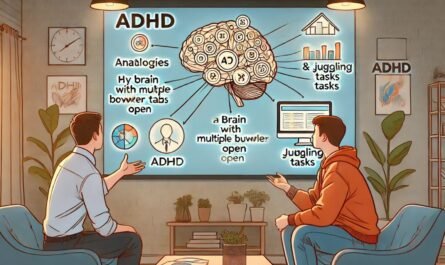Time blindness, a term often associated with ADHD, is a neurological condition characterized by an individual’s inability to accurately perceive the passage of time. This can manifest as underestimating how long tasks will take, procrastination, and difficulties with punctuality and planning. But time blindness doesn’t just plague those with ADHD; it’s seen in conditions like autism, anxiety, and even after traumatic brain injuries.
Key Takeaways – Time Blindness
- Time blindness is a common issue among individuals with ADHD but also occurs in other conditions like autism and anxiety.
- Strategies for managing time blindness include breaking down tasks, using visual aids, establishing routines, and practicing mindfulness.
- Personal adjustments and self-reflection are crucial in developing a better relationship with time.
- External influences from our fast-paced world can aggravate time blindness, necessitating a mindful approach to time management.
Understanding Time Blindness
Time blindness arises from challenges in executive functioning and attention regulation. For individuals with ADHD, engaging in directed attention is particularly strenuous, leading them to gravitate towards tasks that activate automatic attention, like hobbies or interests, often resulting in lost track of time. The modern world, with its relentless pace and constant distractions, only exacerbates these challenges, making time management increasingly difficult.
Strategies for Managing Time Blindness
Managing time blindness involves a combination of tools, strategies, and self-awareness. Simple yet effective tactics include breaking tasks into smaller chunks, using visual aids like timers and calendars, and setting clear, audible reminders. Establishing routines and rituals can also provide the necessary structure to navigate daily life. Moreover, cultivating mindfulness and taking regular breaks can enhance present-moment awareness, improving time perception.
Personal adjustments, like wearing a watch, setting multiple alarms, and employing the Pomodoro technique, can also significantly help. It’s essential to build buffer time into schedules to account for unexpected delays, thereby reducing stress and improving punctuality. Regular self-reflection, through journaling or meditation, allows for better understanding and management of one’s time perception challenges.
The Intersection with Other Conditions
Time blindness is not exclusive to ADHD but is prevalent in various other conditions affecting executive function, such as autism, anxiety, depression, and more. Each of these conditions can alter how an individual perceives and manages time, often leading to similar struggles in daily functioning and social interactions.
The complexities of time blindness extend beyond mere disorganization; they touch on deeper aspects of neurological functioning and personal well-being. Understanding and addressing this condition requires a holistic approach, combining practical time management strategies with self-compassion and awareness. By adopting these strategies, individuals can navigate their days with more clarity and less stress, leading to a more balanced and fulfilling life.
For further information and detailed strategies, the following sources provide comprehensive insights: Shimmer.care, Cleveland Clinic, Well+Good, Psychology Today, Understood.org, and Psychreg (Shimmer ADHD Coach) (Cleveland Clinic) (Well+Good) (Psychology Today) (Understood) (Psychreg).
Additionally, exploring how time blindness intersects with other aspects of mental health can provide a more comprehensive understanding, as seen in the resources provided by Paul Wellness, such as What are the Key Signs of Stress Affecting Mental Health?, Why Might Someone Avoid Getting Help for a Mental Health Concern?, Mental Instability: Navigating the Complex Landscape, Understanding Postpartum Mental Disorders, and Coping with New Job Stress.
Detailed Questions Relevant to Time Blindness
1. How can time blindness manifest differently in individuals with ADHD compared to those with autism?
Time blindness presents unique challenges depending on the condition. In ADHD, time blindness often leads to difficulties in estimating the length of time needed for tasks, leading to procrastination or poor time management. Individuals might lose track of time due to hyperfocus on activities that they find engaging or enjoyable. In contrast, individuals with autism may struggle with time blindness due to differences in abstract thinking and executive functioning, making it hard for them to understand and manage non-concrete concepts like time.
For those with ADHD, time blindness can result in underestimation or overestimation of how much time activities will take, leading to rushed work or missed deadlines. They might also have trouble transitioning between tasks, contributing to a chaotic daily schedule. Conversely, autistic individuals might face challenges due to a more structured need for routines and difficulties adapting to unexpected changes in schedules or plans.
Both groups may benefit from structured routines, visual time aids, and strategies that break tasks into smaller, manageable pieces. However, strategies might need to be tailored specifically to suit the different ways ADHD and autism affect time perception and management.
- ADHD-related time blindness often involves problems with procrastination and hyperfocus.
- Autism-related time blindness can stem from difficulties with abstract thinking and a need for routine.
- Tailored strategies, such as visual aids and structured routines, can help manage time blindness for both conditions.
2. What role does the cerebellum play in time blindness, particularly in individuals with ADHD?
The cerebellum, a part of the brain associated with time perception, plays a crucial role in time blindness, especially in individuals with ADHD. Differences in this area can lead to an inaccurate sense of time, affecting their ability to manage daily activities effectively. This misperception can manifest as difficulties in transitioning between tasks, underestimating the time required for tasks, or struggling to adhere to schedules.
For individuals with ADHD, these cerebellum-related differences result in significant challenges in time management, contributing to the core symptoms of the condition. They may find it hard to complete a series of tasks efficiently or maintain productivity levels consistent with their peers. This can impact their personal and professional life, leading to a perception of unreliability or inconsistency.
Understanding the role of the cerebellum in time blindness can lead to better-targeted interventions and coping strategies. For instance, employing visual reminders, breaking down tasks, and using the Pomodoro technique can help individuals with ADHD better manage their time and tasks, improving their daily functioning and reducing the negative impacts of time blindness.
- The cerebellum is linked to time perception, affecting time management in ADHD.
- Differences in the cerebellum lead to challenges in transitioning and estimating task durations.
- Targeted interventions, like visual reminders and task breakdown, can mitigate these challenges.
3. How can body doubling assist individuals struggling with time blindness due to ADHD?
Body doubling, a technique where another person is present while an individual works on tasks, can significantly assist those with ADHD struggling with time blindness. This approach provides a supportive presence that can help maintain focus, keep track of time, and stay accountable. The presence of a body double can deter procrastination and hyperfocus on non-priority tasks, common issues for those with time blindness.
This technique does not necessarily involve direct interaction; the mere presence of another person working alongside the individual can provide the structure and motivation needed to stay on task. Virtual body doubling, where individuals work in sync with others online, has become increasingly popular, providing the same benefits without the need for physical presence. This can be particularly helpful for remote workers or those who spend long periods alone.
Implementing body doubling into a daily routine can help individuals with ADHD improve their time management and productivity. By fostering a sense of accountability and reducing the likelihood of time-wasting activities, body doubling serves as a practical strategy to combat the effects of time blindness.
- Body doubling provides support and accountability, helping individuals with ADHD stay focused.
- It can be conducted physically or virtually, offering flexibility in implementation.
- Incorporating body doubling can improve time management and reduce procrastination.
4. Why is flexibility crucial for individuals suffering from time blindness, and how can it be cultivated?
Flexibility is essential for individuals suffering from time blindness because rigid schedules and unforeseen changes can exacerbate stress and disorganization. Being flexible allows individuals to adapt to changes more easily, reducing anxiety and improving their ability to manage time effectively. It helps in accommodating the unpredictable nature of time perception issues, enabling better coping and adjustment in daily life.
Cultivating flexibility involves learning to accept uncertainty and adjust plans as needed. This can include setting buffer times between tasks, allowing for deviations from the planned schedule, and adopting a more forgiving approach towards time management mistakes. Developing a mindset that accommodates change can decrease stress and make time management more achievable.
Practicing mindfulness and staying present can aid in cultivating flexibility. Mindfulness practices help individuals remain in the moment, making them more aware of their actions and decisions, including those related to time management. By focusing on the present, they can more effectively respond to current demands and plan for immediate future tasks, reducing the stress associated with time blindness.
To build flexibility, individuals can also experiment with different time management techniques to find what best suits their personal rhythm and lifestyle. This trial-and-error approach encourages a more adaptable mindset, as individuals learn not to be overly attached to specific outcomes or schedules. Recognizing that some level of unpredictability is normal can help alleviate the pressure of sticking rigidly to plans, making time management a more fluid and less stressful process.
- Flexibility reduces stress and improves adaptability in managing time.
- Mindfulness and acceptance of change are key to cultivating flexibility.
- Experimenting with different strategies can help find personalized solutions for better time management.
5. What strategies can individuals with time blindness employ to improve their relationships affected by chronic tardiness or missed deadlines?
Time blindness can significantly impact relationships due to chronic tardiness or missed deadlines, leading to misunderstandings and frustrations. Individuals can improve their relationships by communicating openly about their challenges with time management and seeking understanding from friends, family, and colleagues. This openness can foster empathy and lead to collaborative solutions, such as setting mutual reminders or establishing more flexible meeting times.
Employing specific strategies, such as setting earlier “personal deadlines” or using alarms with ample lead time, can help manage expectations and improve punctuality. By actively working to mitigate the impact of time blindness on others, individuals can show their commitment to maintaining strong relationships despite their challenges. Regular check-ins and updates can also keep others informed and involved, reducing the likelihood of misunderstandings or disappointments.
Improving organizational skills and adopting reliable time management tools can further enhance relationship dynamics. Utilizing calendars for important dates, scheduling regular social interactions, and planning for quality time can help ensure that relationships are not neglected due to time management issues. By prioritizing relationships and making concerted efforts to manage time effectively, individuals can mitigate the negative impact of time blindness on their social and professional lives.
- Open communication about time blindness can foster understanding in relationships.
- Setting personal deadlines and using alarms can improve punctuality and reliability.
- Employing organizational tools and prioritizing relationships can mitigate the negative impacts of time blindness.
10 FAQ Questions with Responses
1. What is time blindness?
Time blindness is a term used to describe the inability to accurately perceive and manage time, commonly associated with ADHD but also present in other conditions.
2. Can time blindness be cured?
While time blindness cannot be “cured,” strategies and tools can significantly improve time management and perception.
3. Is time blindness only related to ADHD?
No, time blindness can also be associated with conditions like autism, anxiety, depression, and traumatic brain injuries.
4. How does time blindness affect daily life?
Time blindness can affect daily life by leading to procrastination, missed deadlines, and difficulties with punctuality and planning.
5. Can technology help with time blindness?
Yes, technology such as digital calendars, alarms, and time-tracking apps can be helpful in managing time blindness.
6. How can body doubling help with time blindness?
Body doubling, having someone else present while working, can help individuals stay focused and manage their time better.
7. What is the Pomodoro technique?
The Pomodoro technique involves working for short focused intervals (usually 25 minutes), followed by short breaks, to improve productivity and time awareness.
8. Can time blindness affect relationships?
Yes, chronic tardiness and missed deadlines can strain relationships, but communication and effective strategies can mitigate these issues.
9. Should people with time blindness see a professional?
Yes, consulting with a healthcare provider can provide strategies and support to manage time blindness more effectively.
10. Are there specific exercises to improve time perception?
Practicing time estimation, using timers, and engaging in mindfulness exercises can help improve time perception and management.


